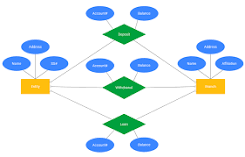ERDs are used to take complex data relationships and display them in a simplified diagram. This can help people see the way entities relate to one another and how data is transferred. There are two types of ERDs (Chen and Crow’s Foot). In Chen’s diagram there are three symbols: rectangle (entity), oval (attributes), and diamond (relationships). In Crow’s Foot diagram, the symbols are a rectangle with a header that entails the entity and underneath there is a list of the attributes. To display relationships, there are arrows that are labeled with the relationship between the entities. There are various arrows that mark the cardinality between entities, one-to-one relationship, one-to-many, and many-to-one. There’s also one to zero to one, one to zero to many and many to zero to one. These arrows represent if a transaction is not completed. ERDs are useful to display how data is relayed through a series of entities.

Hi Rachel,
I thought this was a good overview of the different types of ERDs. Is there a specific ERD that you prefer or recommend using? Personally, I prefer Crow’s Foot because although it can be more tedious to memorize, I think it provides more insight into how the relationships are related. I also find it more organized than Chen’s notation because there are less entities to look at. Chen’s notation is definitely easier to get the hang of if you don’t know the Crow Foot notation key well, and can be helpful for a small amount of entities. As you start adding more entities to the diagram, though, if you know the Crow Foot notation key, it is easy to visualize the data as well as quickly find pieces of information.
Hi Rachel, I think you had a great explanation of this topic! I think I prefer Chen’s diagram based on the various symbols because I think I find it easier to comprehend and show a better explanation! I really like ERD’s because I think that they are great for businesses to really see their organization on a different scale and be able to look at various parts of their business itself and identify any problems or concerns in those areas.